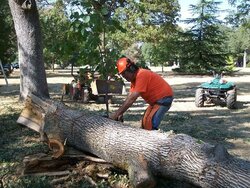I would like to know where to get some wood seasoning facts.
All I see and hear is, “age it one year minimum, three years is betterâ€.
This sounds like a bunch of bunk that just gets repeated because nobody has any facts.
My Questions are;
Since most of the moisture comes out of the end grain, how does the length of a split influence the drying time? There is probable a big time difference between a 15 inch long split and a 20 inch long split drying.
What is ratio of moisture leaving end verses sideways? This would also answer does width of split greatly change the time.
How does average ambient humidity affect drying time?
How does temperature of wood affect drying time?
When log moisture is frozen does it stop the process?
My concerns are there is probably a 6 to 1 difference in seasoning times around country.
Lets analyse two scenarios;
#1
Southwest location.
15 inch slong plits
Summer day ambient over 100 F
Low humidity
100% sunshine most days.
Wood stored in direct sunlight. Therefore at 130 F surface temperature.
Longer warmer winter days.
Winter daytime above freezing.
#2
Upper Midwest
20 inch splits
Summer ambient 80 F
High humidity
Frequent clouds and thunderstorms
Wood stored in shed out of sunlight so only at air temp.
Short cold winter days.
Winter daytime below freezing most of the time.
If you look at solar heating or solar panel charts there is about a 4 to 1 difference around the country.
Add to this great humidity differences and shade verses sun.
Bases on all of the above differences, how can we make generic statements of wood aging times?
Can we get some facts on the subject?
I keep my wood, 15 inches long, outside with a clear plastic top cover. It is 100 to 110 for most of the summer. The wood gets up to 130 F in low humidity.
My guess is in 3 summer months the wood will age as much as it would take a year for 20 inch wood, in Minnesota, in a wood shed.
All I see and hear is, “age it one year minimum, three years is betterâ€.
This sounds like a bunch of bunk that just gets repeated because nobody has any facts.
My Questions are;
Since most of the moisture comes out of the end grain, how does the length of a split influence the drying time? There is probable a big time difference between a 15 inch long split and a 20 inch long split drying.
What is ratio of moisture leaving end verses sideways? This would also answer does width of split greatly change the time.
How does average ambient humidity affect drying time?
How does temperature of wood affect drying time?
When log moisture is frozen does it stop the process?
My concerns are there is probably a 6 to 1 difference in seasoning times around country.
Lets analyse two scenarios;
#1
Southwest location.
15 inch slong plits
Summer day ambient over 100 F
Low humidity
100% sunshine most days.
Wood stored in direct sunlight. Therefore at 130 F surface temperature.
Longer warmer winter days.
Winter daytime above freezing.
#2
Upper Midwest
20 inch splits
Summer ambient 80 F
High humidity
Frequent clouds and thunderstorms
Wood stored in shed out of sunlight so only at air temp.
Short cold winter days.
Winter daytime below freezing most of the time.
If you look at solar heating or solar panel charts there is about a 4 to 1 difference around the country.
Add to this great humidity differences and shade verses sun.
Bases on all of the above differences, how can we make generic statements of wood aging times?
Can we get some facts on the subject?
I keep my wood, 15 inches long, outside with a clear plastic top cover. It is 100 to 110 for most of the summer. The wood gets up to 130 F in low humidity.
My guess is in 3 summer months the wood will age as much as it would take a year for 20 inch wood, in Minnesota, in a wood shed.




